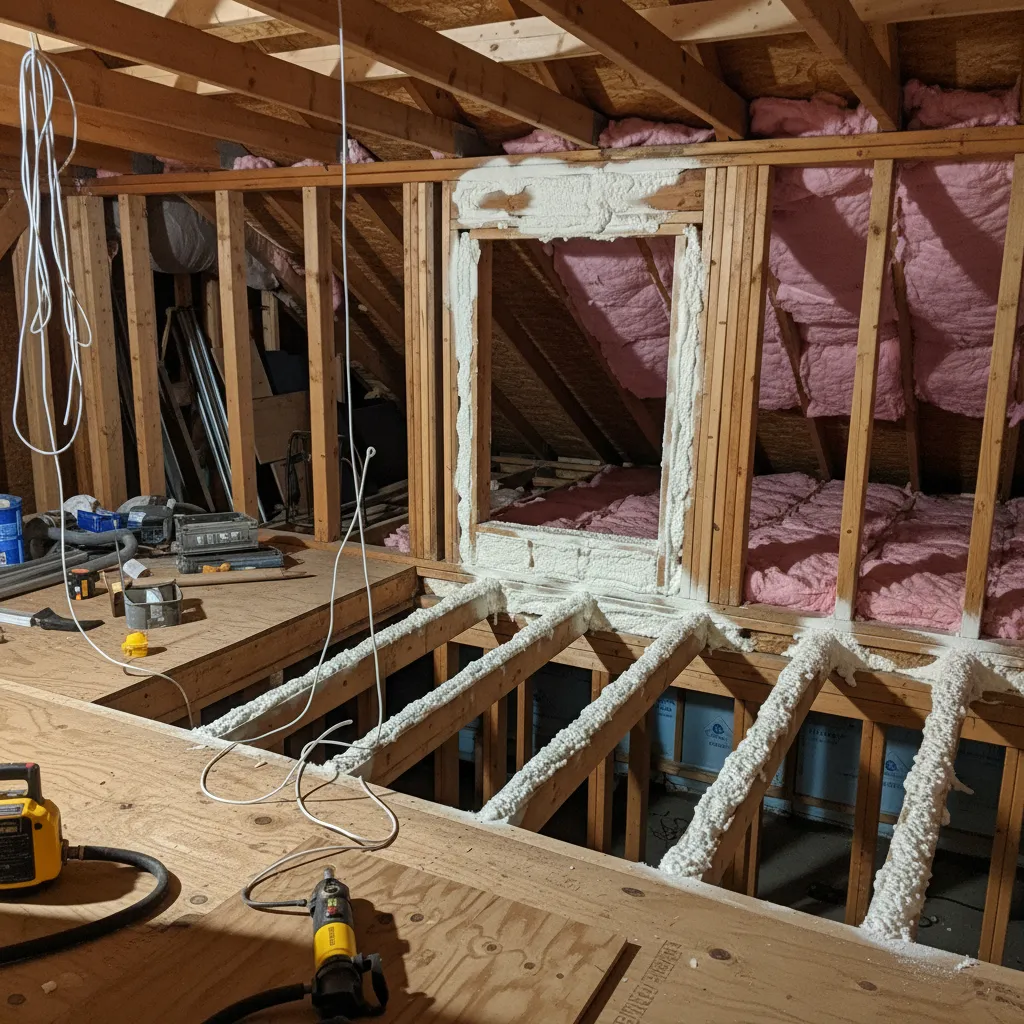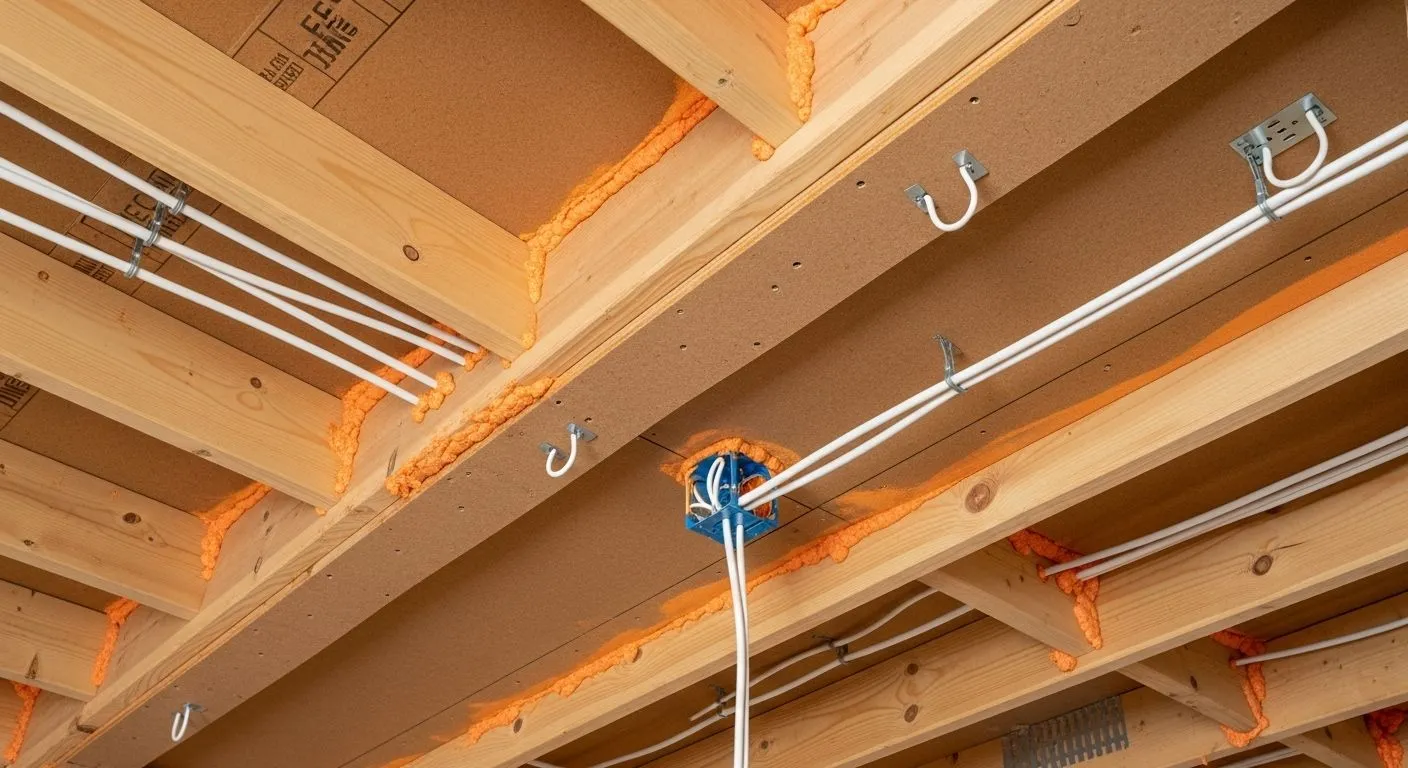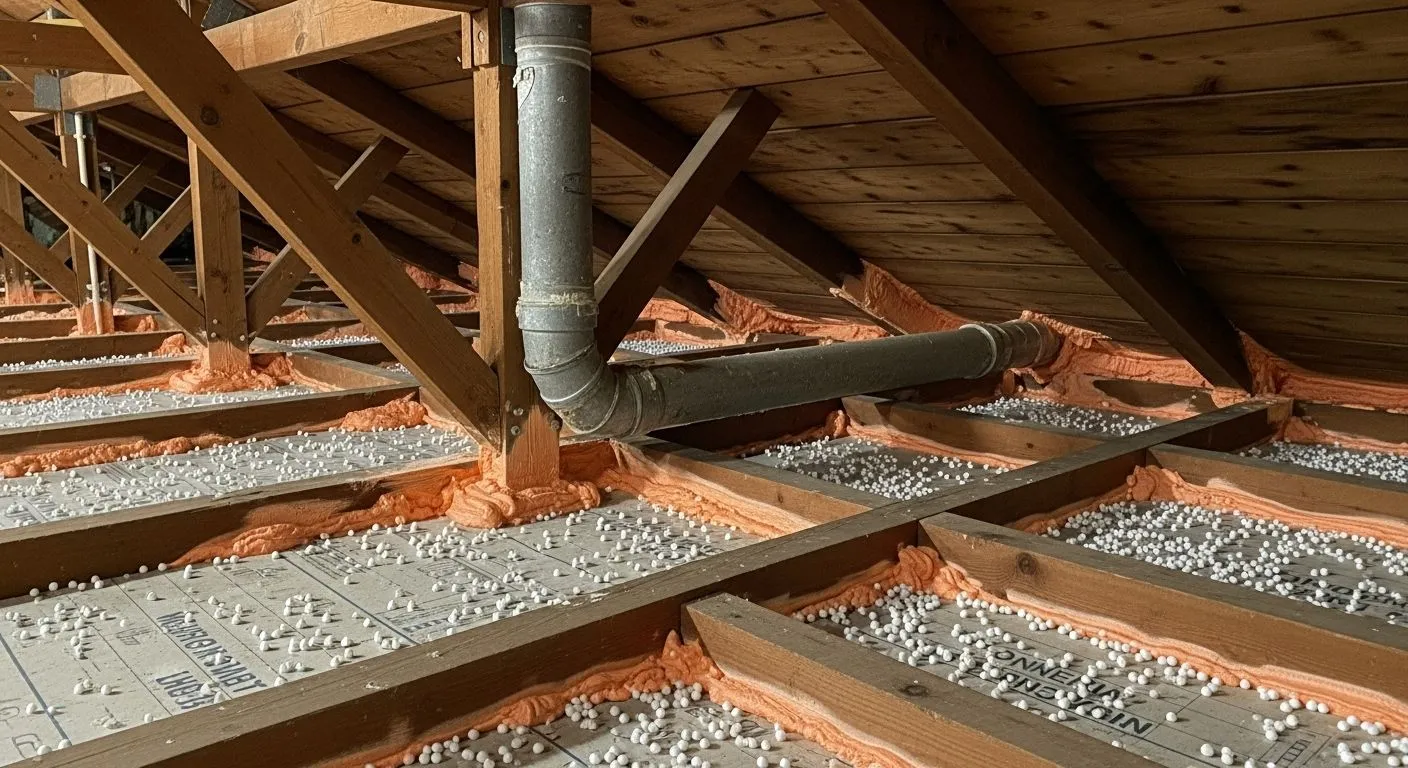
You feel it every winter. That stubborn draft that seems to come from nowhere, making you turn up the thermostat just one more degree. You notice it in the summer, too, when your air conditioner runs constantly but some rooms never quite cool down. These aren’t just minor annoyances; they are symptoms of a much larger, more expensive problem: air leakage. Your home is likely losing a significant portion of its conditioned air through countless tiny cracks, gaps, and holes, forcing your HVAC system to work overtime and driving up your energy bills month after month.
This is where air sealing comes in. It’s not just about adding a bit of weatherstripping around a door. It’s a comprehensive process of finding and sealing these hidden air leaks throughout your home’s structure, from the attic floor to the basement rim joists. Think of it as creating a continuous, protective barrier between your living space and the outside elements. For years, homeowners have focused on insulation, which is certainly important, but without effective air sealing, that insulation can’t do its job properly. Air moving through insulation drastically reduces its effectiveness.
Before diving into the specifics, it’s essential to grasp the core concept of air sealing and the physics that make it so necessary. Many people confuse air sealing with insulation, but they serve two very different, though complementary, functions. Insulation slows the transfer of heat, while air sealing stops the movement of air. You need both for a high-performing home.
At its simplest, air sealing is the process of controlling airflow between the inside of your home and the outside. This involves using materials like caulk, spray foam, and weatherstripping to close unintended openings in your home’s “building envelope.”
The goal isn’t to make your home completely airtight, which would be unhealthy. The goal is to stop uncontrolled air leakage so that you can control ventilation intentionally. The U.S. Department of Energy estimates that air leaks can account for a significant portion of a home’s heating and cooling costs, often wasting 15% to 25% of the energy used.
Imagine your home is wrapped in a protective shell. This shell, which includes your roof, foundation, exterior walls, windows, and doors, is called the building envelope. Its job is to keep the conditioned air in and the unconditioned air out.
However, this envelope is rarely perfect. It’s full of necessary penetrations for plumbing, electrical wiring, vents, and chimneys. Over time, building materials can settle and shift, creating even more gaps. Every one of these openings is a potential pathway for air to leak in or out, compromising the integrity of the envelope.
Air leaks hurt your wallet and your comfort in two primary ways:
One of the most powerful forces driving air leakage is the “stack effect,” which works like a chimney. During the winter, warm air inside your house is lighter and more buoyant than the cold air outside. This warm air rises and pushes its way out through any available gaps in your attic, ceilings, and upper walls.
As this air escapes, it creates a pressure difference, pulling cold outside air into the lower levels of your home through cracks in the foundation, around windows, and under doors. This constant, invisible cycle of air exchange is a leading cause of high heating bills and cold drafts. Air sealing the highest and lowest points of your home is the most effective way to disrupt the stack effect.
You can’t seal a leak if you don’t know where it is. While some sources of air leakage are obvious, many of the most significant ones are hidden from plain sight. A professional energy audit using tools like a blower door is the most accurate way to find them, but you can start by inspecting these common problem areas.
These are the places most people think of first. Gaps around window and door frames, worn-out weatherstripping, and unsealed mail slots can be big sources of drafts. Similarly, electrical outlets and switch plates on exterior walls often have small gaps around them that add up to a surprising amount of air leakage.
The most significant air leaks are almost always found in the attic and the foundation area (basement or crawl space). These areas connect your living space to the outside world and are full of hidden pathways for air to travel.
Expert Tip: The attic floor is the single most important boundary to air seal. Because of the stack effect, sealing leaks here prevents the warm air from escaping in the winter, which in turn reduces the amount of cold air being pulled into your home’s lower levels.
Anywhere a pipe, wire, or duct passes through a wall, floor, or ceiling is a potential air leak. These penetrations are often oversized, leaving a gap around the utility itself. Soffits in kitchens and bathrooms, as well as chases for chimneys or plumbing, are also major hidden pathways for air to move between floors and into the attic.
To help you prioritize, here’s a breakdown of common leak points and how they are typically addressed.
| Leakage Location | Potential Impact | Common Sealing Method |
|---|---|---|
| Attic Access Hatch | High | Weatherstripping, insulated cover |
| Recessed Light Fixtures | High | Airtight-rated covers, caulk |
| Plumbing/Wiring Penetrations | High | Spray foam, caulk |
| Rim Joists (Basement) | High | Spray foam, rigid foam board |
| Windows & Doors | Medium to High | Caulk, weatherstripping |
| Chimney/Flue Chases | High | Metal flashing, high-temp sealant |
| Electrical Outlets/Switches | Medium | Foam gaskets, caulk |
| Ductwork Connections | Medium | Mastic sealant, foil tape |
Effective air sealing relies on using the right materials for the right job and, in a professional setting, diagnostic tools to measure the results. Understanding these can help you appreciate the thoroughness of a professional job or tackle some simpler DIY tasks.
These three materials are the workhorses of air sealing.
Expert Tip: When applying caulk, ensure the surface is clean and dry. For a clean line, cut the tip of the caulk tube at a 45-degree angle to a size that matches the gap you’re filling. Push the caulk into the gap rather than pulling it over the top for a better seal.
While you can find many leaks with a visual inspection or by feeling for drafts, professionals use specialized equipment to pinpoint leaks with precision.
Many homeowners can tackle basic air sealing tasks like weatherstripping doors or caulking windows. These are low-risk, high-reward projects.
However, for a truly comprehensive job, especially in hard-to-reach areas like the attic and basement, hiring a professional is often the best investment. A professional has the diagnostic tools to find all the leaks, the experience to seal them correctly using the right materials, and the knowledge to address ventilation needs. A poorly executed air sealing job can be ineffective or, in some cases, create moisture issues. Whichever path you choose, understanding the value proposition is key to making an informed decision.
Key Takeaways: The Value Proposition of Air Sealing
Air sealing is more than just a home improvement project; it’s a strategic investment in your property. The returns are both immediate and long-term.

The decision to invest in air sealing becomes much easier when you understand the full scope of the benefits. While lower energy bills are the most celebrated advantage, the improvements to your home’s health, comfort, and durability are just as valuable.
This is the most direct and measurable return. By preventing conditioned air from leaking out and unconditioned air from seeping in, your heating and cooling systems don’t have to run as long or as often to maintain your desired temperature. A report from ENERGY STAR suggests that combining air sealing with proper insulation can save homeowners up to 20% on their annual energy bills. For the average American household, this can translate into hundreds of dollars in savings each year.
Your home’s air leaks are a two-way street. It’s not just conditioned air getting out; it’s also outdoor pollutants getting in. Dust, pollen, moisture, and even soil gases from a crawl space can be pulled into your living area through unsealed gaps. According to the U.S. Environmental Protection Agency, concentrations of some pollutants are often two to five times higher indoors than outdoors. By sealing the building envelope, you take control of how and where air enters your home, allowing you to filter it properly and create a healthier environment for your family.
This is a benefit you’ll feel every day. Air sealing is one of the most effective ways to eliminate cold drafts in the winter and reduce hot, humid spots in the summer. It leads to more consistent temperatures throughout the house, from room to room and floor to floor.
Furthermore, air sealing protects your home’s structure. When warm, moist indoor air leaks into a cold attic or wall cavity during the winter, it can condense. This moisture can lead to mold, mildew, and rot over time, causing serious structural damage. A well-sealed home is a more durable home.
Energy efficiency is becoming an increasingly important factor for homebuyers. An appraisal study conducted for the National Association of Realtors found that homes with energy-efficiency certifications and features often sell for a premium. Documented improvements like professional air sealing can be a strong selling point, demonstrating that the home is well-maintained, comfortable, and less expensive to operate.
A professional air sealing project is a systematic process designed to identify, prioritize, and resolve leaks for maximum impact. While every home is different, the general workflow follows a logical path from assessment to verification.
The process begins with a comprehensive home energy audit. A trained technician will inspect your home from top to bottom and perform a blower door test. This test is essential for quantifying your home’s total air leakage and pinpointing the exact location of the most significant leaks. The audit provides the data needed to create an effective and cost-efficient plan.
Not all leaks are created equal. Based on the audit findings, the technician will develop a prioritized action plan. The plan focuses on sealing the leaks that will provide the biggest improvement in energy savings and comfort for the cost. This almost always means starting with the attic and basement or crawl space, as these areas offer the greatest potential for improvement due to the stack effect.
Expert Tip: A good contractor will walk you through the results of the audit, showing you photos or infrared images of the problem areas and explaining why certain spots are a higher priority than others. You should have a clear understanding of the proposed work before it begins.
With the plan in place, the sealing work begins. Technicians will use the appropriate materials for each type of gap. This might involve:
Once the sealing work is complete, a good contractor doesn’t just pack up and leave. They perform a second blower door test. This “test-out” procedure verifies the effectiveness of the work done. The results can be compared directly to the initial test, showing a measurable reduction in the home’s overall air leakage rate. This gives you concrete proof of the improvement and peace of mind that the job was done right.
A common concern among homeowners is, “If I seal my house up, will it be able to breathe?” This is a valid question, and the answer gets to the heart of modern building science. The mantra is: “Build it tight, ventilate it right.”
Houses do need a constant supply of fresh air. Ventilation is necessary to exhaust stale air, moisture, and indoor pollutants (like cooking fumes or off-gassing from furniture) and replace it with fresh, clean air from outside. The problem is that relying on random cracks and holes for this ventilation is completely uncontrolled, inefficient, and unreliable.
Without proper mechanical ventilation, a home that has been very tightly sealed could potentially trap indoor pollutants and excess humidity. High humidity can lead to condensation on windows and, in extreme cases, contribute to mold growth. This is why air sealing should always be considered in conjunction with a home’s overall ventilation strategy.
Instead of relying on accidental leaks, a modern, energy-efficient home uses a mechanical ventilation system to provide a consistent, controlled supply of fresh air. These systems, such as a Heat Recovery Ventilator (HRV) or an Energy Recovery Ventilator (ERV), exhaust stale indoor air while transferring its heat (or coolness in the summer) to the incoming fresh air.
This approach gives you the best of both worlds: an airtight building envelope that saves energy, and a high-quality ventilation system that ensures a healthy indoor environment. For many homes, a professional will determine that the existing leakage rate is high enough that mechanical ventilation isn’t immediately necessary. However, for homes pursuing maximum efficiency, it’s a key part of the equation.

As we’ve seen, air sealing is one of the single most effective investments you can make in your home. It’s the starting point for any meaningful effort to improve energy efficiency, cutting directly to the source of massive energy waste. The benefits are clear: you get a home that costs less to operate, feels more comfortable year-round, provides healthier air for your family, and is better protected against moisture damage.
By sealing the hidden cracks and gaps that riddle your home’s envelope, you are taking control of your indoor environment. You are no longer paying to heat and cool the outdoors. Instead, you’re creating a durable, efficient, and comfortable space that will serve you well for years to come. Use this guide as a reference to understand the process and empower you to make informed decisions about your home’s performance.
Understanding your home’s unique air leakage profile is the first step toward a more efficient and comfortable future. If you’re ready to see how professional air sealing can benefit you, the team at High Country Solutions is here to help. With state-of-the-art diagnostic tools and years of experience, we can provide a comprehensive assessment and a clear plan to improve your home’s performance. Contact High Country Solutions at (307) 248-9063 or send an email to [email protected] to schedule a consultation.
National Association of Realtors (NAR) – This page discusses an appraisal study showing that energy-efficient features can increase a home’s market value.
U.S. Department of Energy – Provides official government information on the benefits and methods of home air sealing for energy savings.
ENERGY STAR – A U.S. government program offering data and recommendations on energy efficiency, including savings from air sealing and insulation.
The cost varies widely depending on the size and age of your home, the extent of the leakage, and the specific areas being addressed. A comprehensive project that includes a full energy audit and extensive sealing in the attic and basement can range from a few hundred to several thousand dollars. However, the investment typically pays for itself in energy savings over a few years.
You can certainly handle basic tasks like caulking baseboards and weatherstripping doors. However, locating and properly sealing the most significant leaks in attics and crawl spaces often requires specific knowledge and equipment. A professional can ensure the job is done safely and effectively without compromising ventilation.
High-quality materials like acrylic latex caulk and polyurethane spray foam are very durable and should last for many years, often for the life of the home. Weatherstripping on high-use doors may need to be replaced every few years due to wear and tear.
No, when done correctly, air sealing helps prevent mold. Mold requires moisture to grow. Air sealing reduces the likelihood of moisture problems by stopping warm, moist indoor air from leaking into cold cavities where it can condense. A professional will also assess ventilation to ensure the home has adequate air exchange.
No, they are different but work together. Air sealing stops air movement, while insulation slows heat transfer. You need a continuous air barrier to ensure your insulation can perform at its rated R-value. Air sealing should almost always be done before adding new insulation.
Air sealing can be done at any time of year. However, it’s often easiest for homeowners to notice the benefits when the work is done just before the peak heating or cooling season.